Child Development: Violence Exposure, Parenting, and Child Behavior
VerifiedAdded on 2022/11/25
|5
|1529
|220
Homework Assignment
AI Summary
This assignment delves into various aspects of child development, examining the effects of violence exposure, parenting styles, and behavioral issues. It explores how children are desensitized to violence through media, leading to potential aggression and psychological trauma. The assignment also addresses the stresses faced by childcare workers, such as burnout, routine changes, and illnesses, and suggests coping mechanisms. Furthermore, it analyzes the decline of family dinners and its impact on children's relationships and cognitive development, along with the effects of abuse and violence on children and families, offering community-based solutions. The concept of good parenting is defined, emphasizing the importance of setting limits, showing love, and encouraging self-reliance. Finally, the assignment addresses challenging behaviors like social isolation and provides strategies for intervention, including encouraging new activities, exercise, and pet ownership to promote socialization. This assignment provides a comprehensive overview of key issues in child development, offering insights into the complex interplay of environmental factors, parenting practices, and children's behavior.
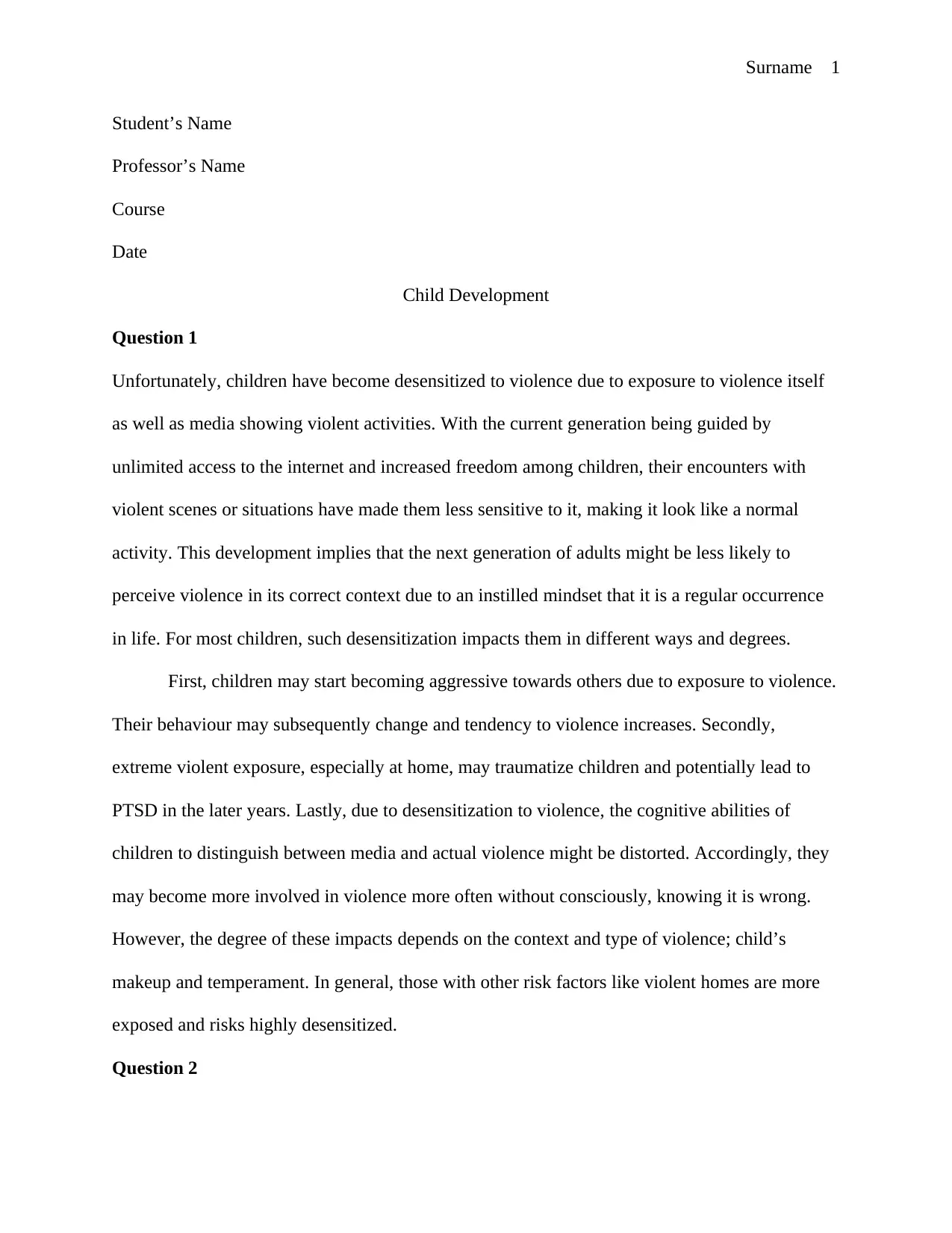
Surname 1
Student’s Name
Professor’s Name
Course
Date
Child Development
Question 1
Unfortunately, children have become desensitized to violence due to exposure to violence itself
as well as media showing violent activities. With the current generation being guided by
unlimited access to the internet and increased freedom among children, their encounters with
violent scenes or situations have made them less sensitive to it, making it look like a normal
activity. This development implies that the next generation of adults might be less likely to
perceive violence in its correct context due to an instilled mindset that it is a regular occurrence
in life. For most children, such desensitization impacts them in different ways and degrees.
First, children may start becoming aggressive towards others due to exposure to violence.
Their behaviour may subsequently change and tendency to violence increases. Secondly,
extreme violent exposure, especially at home, may traumatize children and potentially lead to
PTSD in the later years. Lastly, due to desensitization to violence, the cognitive abilities of
children to distinguish between media and actual violence might be distorted. Accordingly, they
may become more involved in violence more often without consciously, knowing it is wrong.
However, the degree of these impacts depends on the context and type of violence; child’s
makeup and temperament. In general, those with other risk factors like violent homes are more
exposed and risks highly desensitized.
Question 2
Student’s Name
Professor’s Name
Course
Date
Child Development
Question 1
Unfortunately, children have become desensitized to violence due to exposure to violence itself
as well as media showing violent activities. With the current generation being guided by
unlimited access to the internet and increased freedom among children, their encounters with
violent scenes or situations have made them less sensitive to it, making it look like a normal
activity. This development implies that the next generation of adults might be less likely to
perceive violence in its correct context due to an instilled mindset that it is a regular occurrence
in life. For most children, such desensitization impacts them in different ways and degrees.
First, children may start becoming aggressive towards others due to exposure to violence.
Their behaviour may subsequently change and tendency to violence increases. Secondly,
extreme violent exposure, especially at home, may traumatize children and potentially lead to
PTSD in the later years. Lastly, due to desensitization to violence, the cognitive abilities of
children to distinguish between media and actual violence might be distorted. Accordingly, they
may become more involved in violence more often without consciously, knowing it is wrong.
However, the degree of these impacts depends on the context and type of violence; child’s
makeup and temperament. In general, those with other risk factors like violent homes are more
exposed and risks highly desensitized.
Question 2
Paraphrase This Document
Need a fresh take? Get an instant paraphrase of this document with our AI Paraphraser
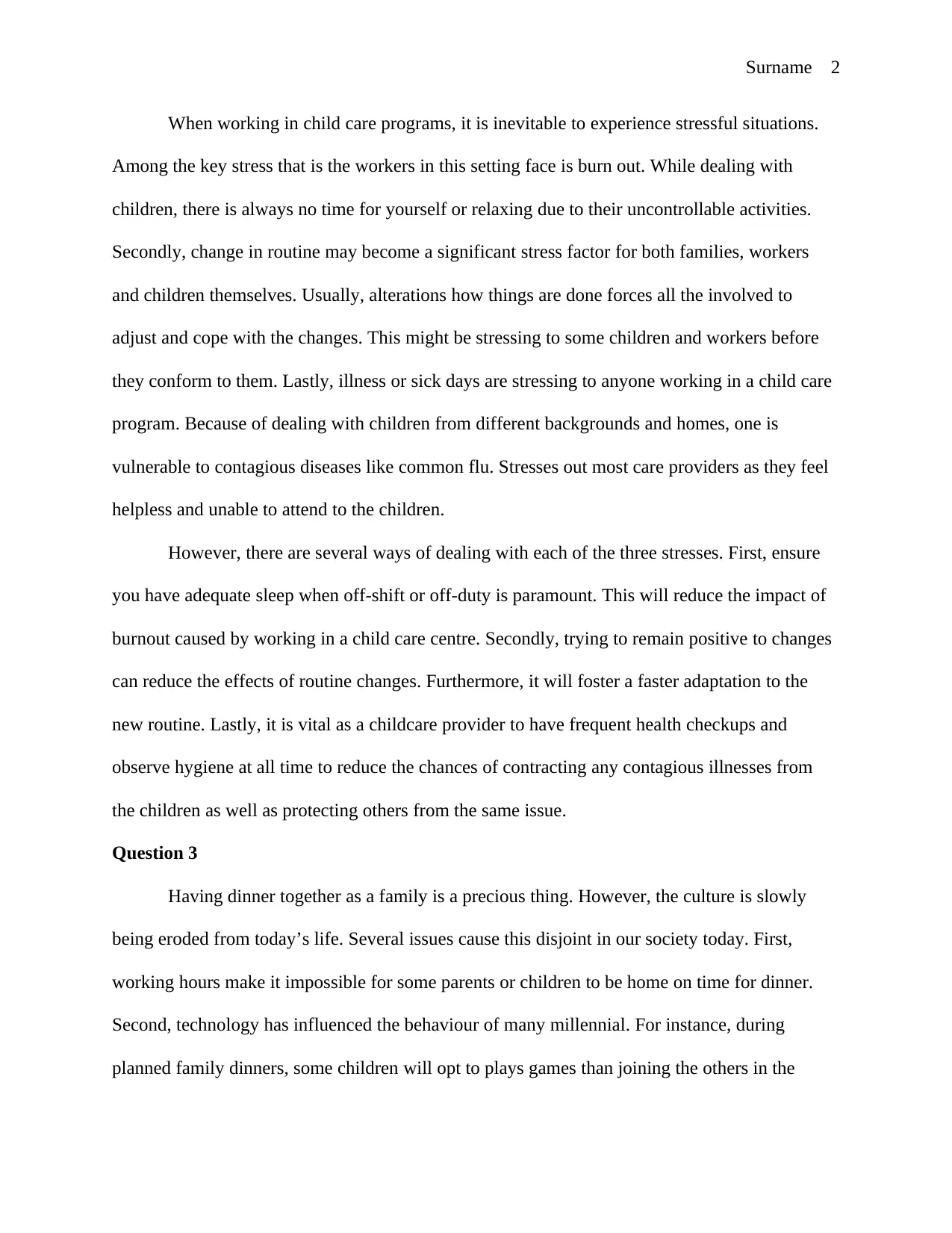
Surname 2
When working in child care programs, it is inevitable to experience stressful situations.
Among the key stress that is the workers in this setting face is burn out. While dealing with
children, there is always no time for yourself or relaxing due to their uncontrollable activities.
Secondly, change in routine may become a significant stress factor for both families, workers
and children themselves. Usually, alterations how things are done forces all the involved to
adjust and cope with the changes. This might be stressing to some children and workers before
they conform to them. Lastly, illness or sick days are stressing to anyone working in a child care
program. Because of dealing with children from different backgrounds and homes, one is
vulnerable to contagious diseases like common flu. Stresses out most care providers as they feel
helpless and unable to attend to the children.
However, there are several ways of dealing with each of the three stresses. First, ensure
you have adequate sleep when off-shift or off-duty is paramount. This will reduce the impact of
burnout caused by working in a child care centre. Secondly, trying to remain positive to changes
can reduce the effects of routine changes. Furthermore, it will foster a faster adaptation to the
new routine. Lastly, it is vital as a childcare provider to have frequent health checkups and
observe hygiene at all time to reduce the chances of contracting any contagious illnesses from
the children as well as protecting others from the same issue.
Question 3
Having dinner together as a family is a precious thing. However, the culture is slowly
being eroded from today’s life. Several issues cause this disjoint in our society today. First,
working hours make it impossible for some parents or children to be home on time for dinner.
Second, technology has influenced the behaviour of many millennial. For instance, during
planned family dinners, some children will opt to plays games than joining the others in the
When working in child care programs, it is inevitable to experience stressful situations.
Among the key stress that is the workers in this setting face is burn out. While dealing with
children, there is always no time for yourself or relaxing due to their uncontrollable activities.
Secondly, change in routine may become a significant stress factor for both families, workers
and children themselves. Usually, alterations how things are done forces all the involved to
adjust and cope with the changes. This might be stressing to some children and workers before
they conform to them. Lastly, illness or sick days are stressing to anyone working in a child care
program. Because of dealing with children from different backgrounds and homes, one is
vulnerable to contagious diseases like common flu. Stresses out most care providers as they feel
helpless and unable to attend to the children.
However, there are several ways of dealing with each of the three stresses. First, ensure
you have adequate sleep when off-shift or off-duty is paramount. This will reduce the impact of
burnout caused by working in a child care centre. Secondly, trying to remain positive to changes
can reduce the effects of routine changes. Furthermore, it will foster a faster adaptation to the
new routine. Lastly, it is vital as a childcare provider to have frequent health checkups and
observe hygiene at all time to reduce the chances of contracting any contagious illnesses from
the children as well as protecting others from the same issue.
Question 3
Having dinner together as a family is a precious thing. However, the culture is slowly
being eroded from today’s life. Several issues cause this disjoint in our society today. First,
working hours make it impossible for some parents or children to be home on time for dinner.
Second, technology has influenced the behaviour of many millennial. For instance, during
planned family dinners, some children will opt to plays games than joining the others in the
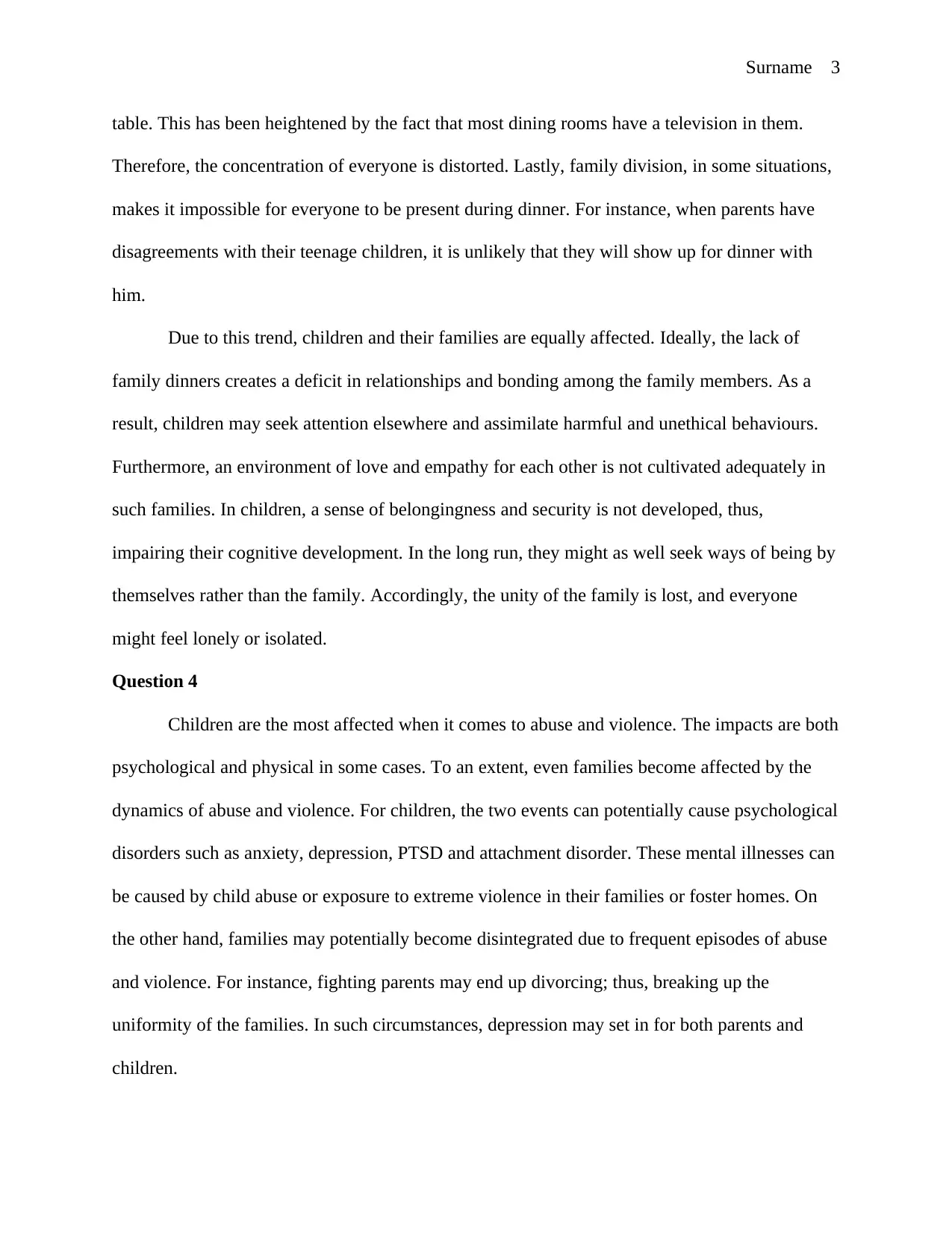
Surname 3
table. This has been heightened by the fact that most dining rooms have a television in them.
Therefore, the concentration of everyone is distorted. Lastly, family division, in some situations,
makes it impossible for everyone to be present during dinner. For instance, when parents have
disagreements with their teenage children, it is unlikely that they will show up for dinner with
him.
Due to this trend, children and their families are equally affected. Ideally, the lack of
family dinners creates a deficit in relationships and bonding among the family members. As a
result, children may seek attention elsewhere and assimilate harmful and unethical behaviours.
Furthermore, an environment of love and empathy for each other is not cultivated adequately in
such families. In children, a sense of belongingness and security is not developed, thus,
impairing their cognitive development. In the long run, they might as well seek ways of being by
themselves rather than the family. Accordingly, the unity of the family is lost, and everyone
might feel lonely or isolated.
Question 4
Children are the most affected when it comes to abuse and violence. The impacts are both
psychological and physical in some cases. To an extent, even families become affected by the
dynamics of abuse and violence. For children, the two events can potentially cause psychological
disorders such as anxiety, depression, PTSD and attachment disorder. These mental illnesses can
be caused by child abuse or exposure to extreme violence in their families or foster homes. On
the other hand, families may potentially become disintegrated due to frequent episodes of abuse
and violence. For instance, fighting parents may end up divorcing; thus, breaking up the
uniformity of the families. In such circumstances, depression may set in for both parents and
children.
table. This has been heightened by the fact that most dining rooms have a television in them.
Therefore, the concentration of everyone is distorted. Lastly, family division, in some situations,
makes it impossible for everyone to be present during dinner. For instance, when parents have
disagreements with their teenage children, it is unlikely that they will show up for dinner with
him.
Due to this trend, children and their families are equally affected. Ideally, the lack of
family dinners creates a deficit in relationships and bonding among the family members. As a
result, children may seek attention elsewhere and assimilate harmful and unethical behaviours.
Furthermore, an environment of love and empathy for each other is not cultivated adequately in
such families. In children, a sense of belongingness and security is not developed, thus,
impairing their cognitive development. In the long run, they might as well seek ways of being by
themselves rather than the family. Accordingly, the unity of the family is lost, and everyone
might feel lonely or isolated.
Question 4
Children are the most affected when it comes to abuse and violence. The impacts are both
psychological and physical in some cases. To an extent, even families become affected by the
dynamics of abuse and violence. For children, the two events can potentially cause psychological
disorders such as anxiety, depression, PTSD and attachment disorder. These mental illnesses can
be caused by child abuse or exposure to extreme violence in their families or foster homes. On
the other hand, families may potentially become disintegrated due to frequent episodes of abuse
and violence. For instance, fighting parents may end up divorcing; thus, breaking up the
uniformity of the families. In such circumstances, depression may set in for both parents and
children.
⊘ This is a preview!⊘
Do you want full access?
Subscribe today to unlock all pages.

Trusted by 1+ million students worldwide
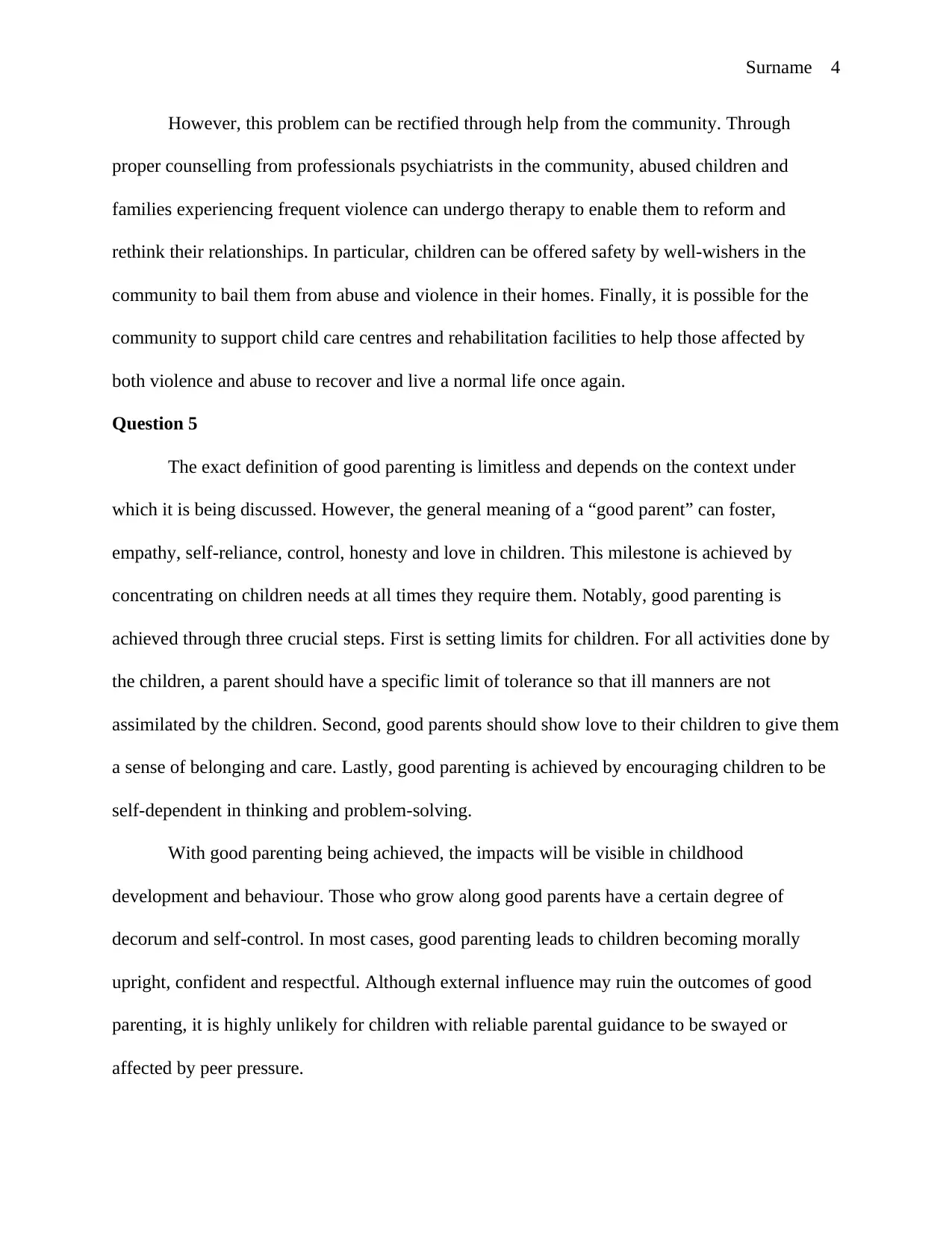
Surname 4
However, this problem can be rectified through help from the community. Through
proper counselling from professionals psychiatrists in the community, abused children and
families experiencing frequent violence can undergo therapy to enable them to reform and
rethink their relationships. In particular, children can be offered safety by well-wishers in the
community to bail them from abuse and violence in their homes. Finally, it is possible for the
community to support child care centres and rehabilitation facilities to help those affected by
both violence and abuse to recover and live a normal life once again.
Question 5
The exact definition of good parenting is limitless and depends on the context under
which it is being discussed. However, the general meaning of a “good parent” can foster,
empathy, self-reliance, control, honesty and love in children. This milestone is achieved by
concentrating on children needs at all times they require them. Notably, good parenting is
achieved through three crucial steps. First is setting limits for children. For all activities done by
the children, a parent should have a specific limit of tolerance so that ill manners are not
assimilated by the children. Second, good parents should show love to their children to give them
a sense of belonging and care. Lastly, good parenting is achieved by encouraging children to be
self-dependent in thinking and problem-solving.
With good parenting being achieved, the impacts will be visible in childhood
development and behaviour. Those who grow along good parents have a certain degree of
decorum and self-control. In most cases, good parenting leads to children becoming morally
upright, confident and respectful. Although external influence may ruin the outcomes of good
parenting, it is highly unlikely for children with reliable parental guidance to be swayed or
affected by peer pressure.
However, this problem can be rectified through help from the community. Through
proper counselling from professionals psychiatrists in the community, abused children and
families experiencing frequent violence can undergo therapy to enable them to reform and
rethink their relationships. In particular, children can be offered safety by well-wishers in the
community to bail them from abuse and violence in their homes. Finally, it is possible for the
community to support child care centres and rehabilitation facilities to help those affected by
both violence and abuse to recover and live a normal life once again.
Question 5
The exact definition of good parenting is limitless and depends on the context under
which it is being discussed. However, the general meaning of a “good parent” can foster,
empathy, self-reliance, control, honesty and love in children. This milestone is achieved by
concentrating on children needs at all times they require them. Notably, good parenting is
achieved through three crucial steps. First is setting limits for children. For all activities done by
the children, a parent should have a specific limit of tolerance so that ill manners are not
assimilated by the children. Second, good parents should show love to their children to give them
a sense of belonging and care. Lastly, good parenting is achieved by encouraging children to be
self-dependent in thinking and problem-solving.
With good parenting being achieved, the impacts will be visible in childhood
development and behaviour. Those who grow along good parents have a certain degree of
decorum and self-control. In most cases, good parenting leads to children becoming morally
upright, confident and respectful. Although external influence may ruin the outcomes of good
parenting, it is highly unlikely for children with reliable parental guidance to be swayed or
affected by peer pressure.
Paraphrase This Document
Need a fresh take? Get an instant paraphrase of this document with our AI Paraphraser
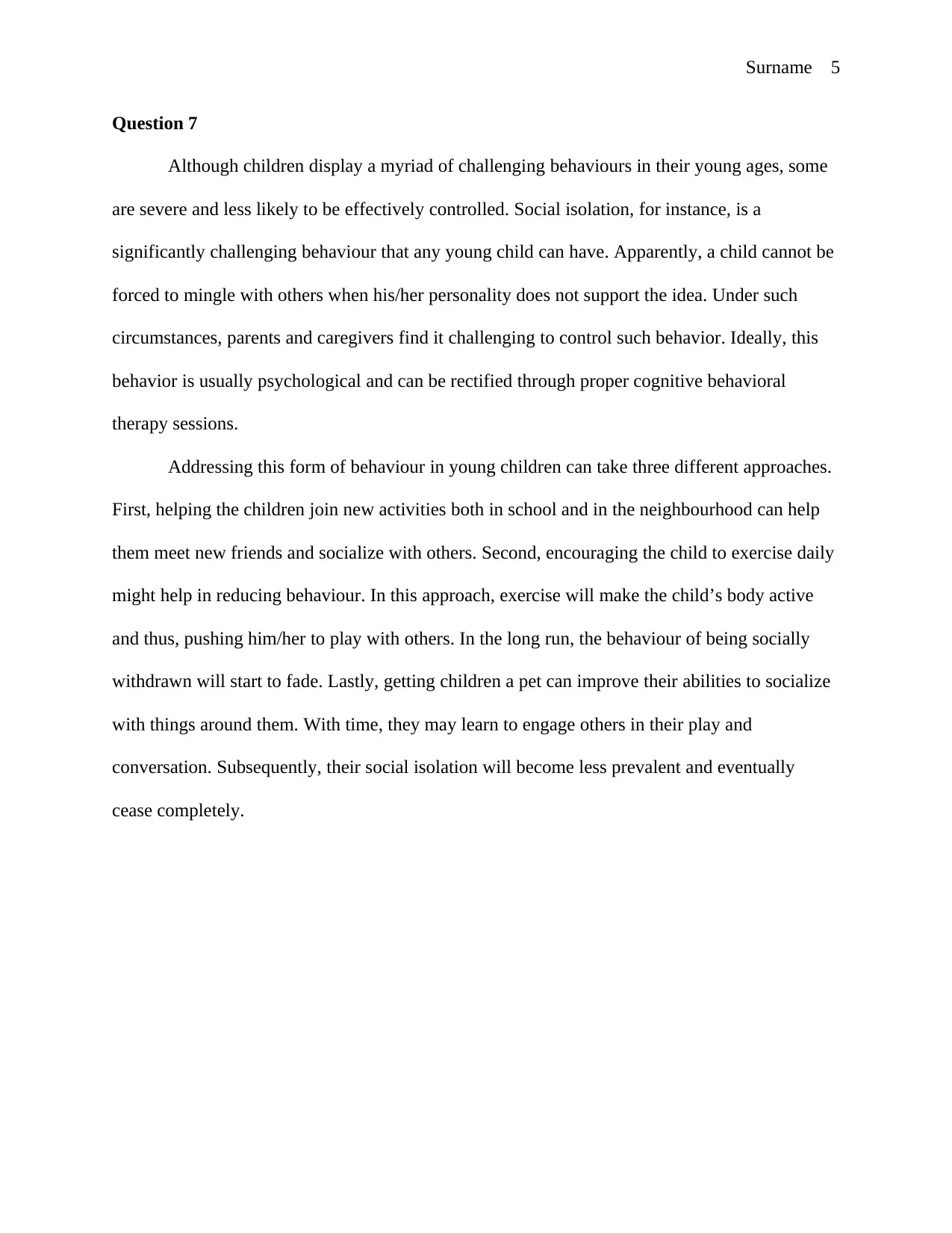
Surname 5
Question 7
Although children display a myriad of challenging behaviours in their young ages, some
are severe and less likely to be effectively controlled. Social isolation, for instance, is a
significantly challenging behaviour that any young child can have. Apparently, a child cannot be
forced to mingle with others when his/her personality does not support the idea. Under such
circumstances, parents and caregivers find it challenging to control such behavior. Ideally, this
behavior is usually psychological and can be rectified through proper cognitive behavioral
therapy sessions.
Addressing this form of behaviour in young children can take three different approaches.
First, helping the children join new activities both in school and in the neighbourhood can help
them meet new friends and socialize with others. Second, encouraging the child to exercise daily
might help in reducing behaviour. In this approach, exercise will make the child’s body active
and thus, pushing him/her to play with others. In the long run, the behaviour of being socially
withdrawn will start to fade. Lastly, getting children a pet can improve their abilities to socialize
with things around them. With time, they may learn to engage others in their play and
conversation. Subsequently, their social isolation will become less prevalent and eventually
cease completely.
Question 7
Although children display a myriad of challenging behaviours in their young ages, some
are severe and less likely to be effectively controlled. Social isolation, for instance, is a
significantly challenging behaviour that any young child can have. Apparently, a child cannot be
forced to mingle with others when his/her personality does not support the idea. Under such
circumstances, parents and caregivers find it challenging to control such behavior. Ideally, this
behavior is usually psychological and can be rectified through proper cognitive behavioral
therapy sessions.
Addressing this form of behaviour in young children can take three different approaches.
First, helping the children join new activities both in school and in the neighbourhood can help
them meet new friends and socialize with others. Second, encouraging the child to exercise daily
might help in reducing behaviour. In this approach, exercise will make the child’s body active
and thus, pushing him/her to play with others. In the long run, the behaviour of being socially
withdrawn will start to fade. Lastly, getting children a pet can improve their abilities to socialize
with things around them. With time, they may learn to engage others in their play and
conversation. Subsequently, their social isolation will become less prevalent and eventually
cease completely.
1 out of 5
Related Documents
Your All-in-One AI-Powered Toolkit for Academic Success.
+13062052269
info@desklib.com
Available 24*7 on WhatsApp / Email
![[object Object]](/_next/static/media/star-bottom.7253800d.svg)
Unlock your academic potential
Copyright © 2020–2025 A2Z Services. All Rights Reserved. Developed and managed by ZUCOL.



